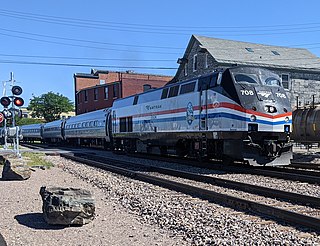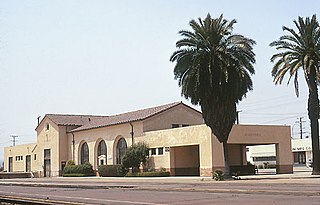
The Ethan Allen Express is a daily passenger train operated by Amtrak in the United States between New York City and Burlington, Vermont, via Albany, New York. One daily round trip is operated on a 310-mile (500 km) north–south route with a 7-hour 35 minute scheduled running time. The train is subsidized by New York and Vermont for the portion north of Albany. It is named for Vermont cofounder and American Revolutionary War hero Ethan Allen.

The Capitol Corridor is a 168-mile (270 km) passenger train route in Northern California operated by Amtrak between San Jose, in the Bay Area, and Auburn, in the Sacramento Valley. The route is named after the two points most trains operate between, San Jose and Sacramento. The route runs roughly parallel to I-880 and I-80. Some limited trips run between Oakland and San Jose. A single daily round trip runs between San Jose and Auburn, in the foothills of the Sierra Nevada. Capitol Corridor trains started in 1991.

The Coast Starlight is a long-distance passenger train operated by Amtrak on the West Coast of the United States between Seattle and Los Angeles via Portland and the San Francisco Bay Area. The train, which has operated continuously since Amtrak's formation in 1971, was the first to offer direct service between Seattle and Los Angeles. Its name is a combination of two prior Southern Pacific (SP) trains, the Coast Daylight and the Starlight.

The Desert Wind was an Amtrak long-distance passenger train that ran from 1979 to 1997. It operated from Chicago to Los Angeles as a section of the California Zephyr, serving Los Angeles via Salt Lake City; Ogden, Utah; and Las Vegas.

Santa Fe Depot is a union station in San Diego, California, built by the Atchison, Topeka and Santa Fe Railway to replace the small Victorian-style structure erected in 1887 for the California Southern Railroad Company. The Spanish Colonial Revival style station is listed on the National Register of Historic Places and is a San Diego Historic Landmark. Its architecture, particularly the signature twin domes, is often echoed in the design of modern buildings in downtown San Diego.

Sacramento Valley Station is an Amtrak railway station in the city of Sacramento, California, at 401 I Street on the corner of Fifth Street, built in 1926 on the site of China Slough. It is the thirteenth busiest Amtrak station in the country, and the second busiest in the Western United States. It is served by four different Amtrak train routes and connecting Amtrak Thruway motorcoaches. It is also the western terminus for the Gold Line of the SacRT light rail system and the Route 30 bus serving California State University, Sacramento.

Simi Valley station is a passenger rail station in the city of Simi Valley, California. Amtrak's Pacific Surfliner from San Luis Obispo to San Diego and Metrolink's Ventura County Line from Los Angeles Union Station to East Ventura stop here.

Davis station is a train station in Davis, California. The station is owned by the city, while the tracks are owned by the Union Pacific Railroad. The station is served by Amtrak California Zephyr, Capitol Corridor, and Coast Starlight trains. It is the primary stop for UC Davis and one of the busiest train stations in the region, serving over 10% of the total Capitol Corridor ridership.

Martinez station is an Amtrak passenger train station in Martinez, California, United States. Located at the west end of downtown Martinez, the station has one side platform and one island platform, which serve three of the four tracks of the Union Pacific Railroad Martinez Subdivision. It is served by the daily California Zephyr and Coast Starlight long-distance trains, five daily round trips of the San Joaquin corridor service, and fifteen daily round trips of the Capitol Corridor service. Martinez is also served by Amtrak Thruway buses plus County Connection, Tri-Delta Transit, and WestCAT local buses.

Chico station is an intercity rail station in the South Campus Neighborhood of Chico, California. It is served by the single daily round trip of the Amtrak Coast Starlight service. The station building was constructed by the Southern Pacific Railroad in 1892; it was listed in the National Register of Historic Places in 2014. The Greyhound bus station is located adjacent to the Amtrak station.

Waterloo station is an Amtrak train station in Waterloo, Indiana. Waterloo is a small town of under 2,500 people; the station primarily serves the vastly larger population of Fort Wayne, which is some 25 miles (40 km) to the south. The station opened in 1990; in 2016, the former New York Central Railroad station building was moved and reopened for passenger use. The station has a waiting room and restroom facilities; it is open for only short periods before trains arrive.

Roseville station is an Amtrak train station in Roseville, California, United States. It is served by the long-distance California Zephyr and regional Capitol Corridor.

The Santa Fe Passenger Depot, also known as Fresno station, is an historic railroad station and transportation hub in downtown Fresno, California. It is served by San Joaquins inter-city passenger trains, Greyhound inter-city buses, and regional transit services including Fresno Area Express and the Fresno County Rural Transit Agency.

Reno station is an Amtrak intercity train station in Reno, Nevada, served by the California Zephyr train. It is also serviced by five times per weekday, and twice on weekends, Amtrak Thruway routes to Sacramento.

The North Star was a passenger train operated by Amtrak between Duluth, Minnesota and Saint Paul, Minnesota. It originally operated from Chicago, Illinois via St. Paul to Superior, Wisconsin and Duluth, but was soon cut back to a Saint Paul–Duluth train. The service relied in part on funding from the state of Minnesota.

Orland was a Southern Pacific Railroad station in Orland, California. The Northern Railway built the line out from Colusa County to Orland, opening for traffic on July 31, 1882. The railroad had assumed management of the town site a few years earlier. The Klamath served the station as late as 1954, and ran between Portland and Oakland, but the stop did not appear in the 1966 timetables. After Amtrak took over nationwide passenger operations, the state lobbied the company in 1974 to add the station as a stop on the Coast Starlight route, running daily from Los Angeles to Seattle. While the station saw service for a time, it was bypassed in 1982. The station building was subsequently moved to Glenn County Fairgrounds.

Storey was an unstaffed train station located in the unincorporated community of Storey, and about 1 mile (1.6 km) southeast of the Fresno River, in Madera County, California, United States. Just prior to its closure in November 2010 and replacement by the new Madera station, this station was served by Amtrak's San Joaquin. Prior to Amtrak, this station was also previously served by Atchison, Topeka and Santa Fe Railroad's (ATSF) San Francisco Chief and its Oakland-Barstow Line.
The Sacramento Subdivision is a rail line owned and operated by the Union Pacific Railroad in the U.S. state of California. The line begins in Marysville as a continuation of the Canyon Subdivision at a junction with the Valley Subdivision, and travels south through the Central Valley to a junction with the Fresno Subdivision in Stockton. South of Downtown Sacramento, the SacRT light rail Blue Line runs adjacent to the right of way until a flyover near Consumnes River Boulevard. The route between Sacramento and Stockton hosts about 12 to 20 freight trains daily as of 2018. Additionally, the Amtrak Coast Starlight runs over the tracks between Marysville and Sacramento.

Alhambra station was a train station in Alhambra, California. It was last served by the Amtrak Sunset Limited.

The Superior Union Depot or Superior station of Superior, Wisconsin was built in 1905, replacing a previous depot, which had burned down in 1904. It was built of Lake Superior brown sandstone and designed by Duluth architects German and Lignell. The depot primarily served the Great Northern Railway, Northern Pacific Railway and Duluth, South Shore and Atlantic Railway.



















